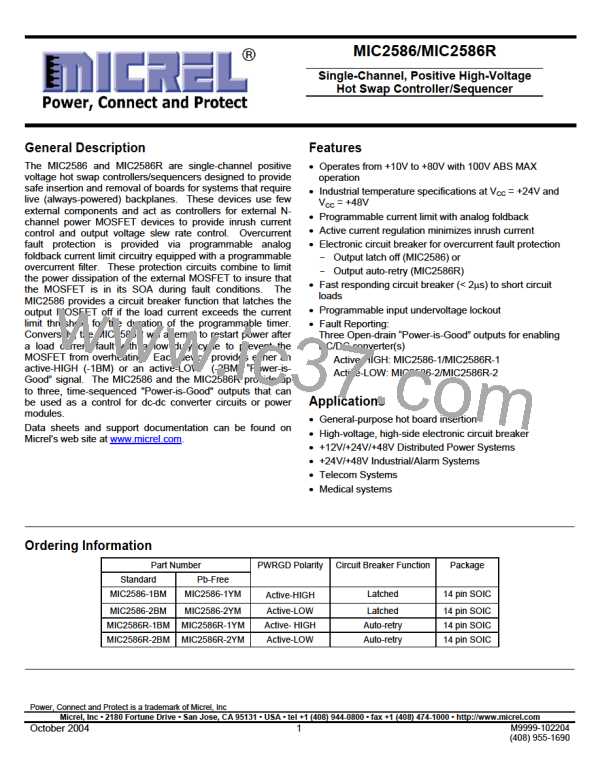Micrel
MIC2586/MIC2586R
Keep in mind that the minimum hot swap load current should
be greater than the application circuit's upper steady-state
load current boundary. Once the lower value of RSENSE has
been calculated, it is good practice to check the maximum
hot swap load current (IHOT_SWAP(MAX)), which the circuit may
let pass in the case of tolerance build-up in the opposite
direction. Here, the worse-case maximum is found using a
VTRIP(MAX) threshold of 55mV and a sense resistor 3% low in
value:
and through RSENSE
.
The voltage drop across RSENSE is
sampled in such a way that the high currents through the
power traces will not introduce significant parasitic voltage
drops in the sense leads. It is recommended to connect the
hot swap controller's sense leads directly to the sense
resistor's metalized contact pads. The Kelvin sense signal
traces should be symmetrical with equal length and width,
kept as short as possible and isolated from any noisy signals
and planes.
55mV
0.97 ×R
56.7mV
IHOT_SWAP(MAX)
=
=
RSENSE(NOM)
(
)
SENSE(NOM)
In this case, the application circuit must be sturdy enough to
operate over a ~1.5-to-1 range in hot swap load currents.
For example, if an MIC2586 circuit must pass a minimum hot
swap load current of 4A without nuisance trips, RSENSE should
be set to:
39mV
RSENSE(NOM)
=
= 9.75mΩ
4A
where the nearest 1% standard value is 9.76mΩ. At the
other tolerance extremes, IHOT_SWAP(MAX) for the circuit in
question is then simply:
Figure 8. 4-Wire Kelvin Sense Connections for RSENSE
Additionally, for designs that implement Kelvin sense
connections that exceed 1” in length and/or if the Kelvin
(signal) traces are vulnerable to noise possibly being injected
onto these signals, the example circuit shown in Figure 9 can
be implemented to combat noisy environments. This circuit
implements a 1.6 MHz low-pass filter to attenuate higher
frequency disturbances on the current sensing circuitry.
However, individual system analysis should be used to
determine if filtering is necessary and to select the
appropriate cutoff frequency for each specific application.
56.7mV
IHOT_SWAP(m ax)
=
= 5.8A
9.76mΩ
With a knowledge of the application circuit's maximum hot
swap load current, the power dissipation rating of the sense
resistor can be determined using P = I2R. Here, The current
is IHOT_SWAP(MAX) = 5.8A and the resistance RSENSE(MIN)
=
(0.97)(RSENSE(NOM)) = 9.47mΩ. Thus, the sense resistor's
maximum power dissipation is:
PMAX = 5.8A 2 × 9.47mΩ = 0.319W
(
) (
)
Other Layout Considerations
A 0.5W sense resistor is a good choice in this application.
Figure 10 is a recommended PCB layout diagram for the
MIC2586-2BM. Many hot swap applications will require load
currents of several amperes. Therefore, the power (VCC and
When the MIC2586/MIC2586R's foldback current limiting
circuit is engaged in the above example, the current limit
would nominally fold back to 1.23A when the output is
shorted to ground.
Return) trace widths (W) need to be wide enough to allow the
current to flow while the rise in temperature for a given
copper plate (e.g., 1oz. or 2oz.) is kept to a maximum of
10°C to 25°C. Also, these traces should be as short as
possible in order to minimize the IR drops between the input
and the load. The feedback network resistor values in Figure
10 are selected for a +24V application. The resistors for the
feedback (FB) and ON pin networks should be placed close
to the controller and the associated traces should be as short
as possible to improve the circuit’s noise immunity. The input
“clamping diode” (D1) is referenced in the “Typical
Application Circuit” on Page 1. If possible, use high-
frequency PCB layout techniques around the GATE circuitry
(shown in the “Typical Application Circuit”) and use a dummy
resistor (e.g., R3 = 0Ω) during the prototype phase. If R3 is
needed to eliminate high-frequency oscillations, common
values for R3 range between 4.7Ω to 20Ω for various power
PCB Layout Considerations
4-Wire Kelvin Sensing
Because of the low value typically required for the sense
resistor, special care must be used to accurately measure
the voltage drop across it. Specifically, the measurement
technique across RSENSE must employ 4-wire Kelvin sensing.
This is simply a means of ensuring that any voltage drops in
the power traces connected to the resistors are not picked up
by the signal conductors measuring the voltages across the
sense resistors.
Figure 8 illustrates how to implement 4-wire Kelvin sensing.
As the figure shows, all the high current in the circuit (from
VCC through RSENSE and then to the drain of the N-channel
power MOSFET) flows directly through the power PCB traces
M9999-102204
(408) 955-1690
October 2004
14

 MICREL [ MICREL SEMICONDUCTOR ]
MICREL [ MICREL SEMICONDUCTOR ]